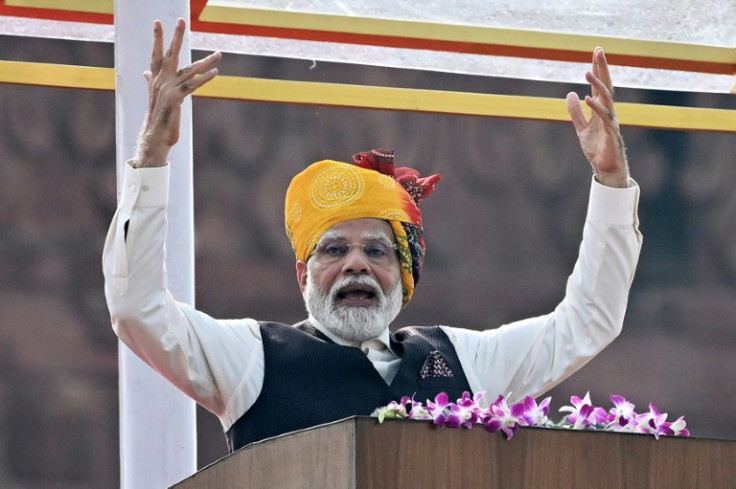India To Overtake Japan, Germany To Become 3rd Largest Economy By 2030: S&P Global

KEY POINTS
- India is currently ranked fifth in terms of the size of its economy at $3.7 trillion in 2023-24
- The country's nominal GDP measured in USD terms is forecast to increase from $3.5 trillion in 2022 to $7.3 trillion by 2030
- The increase in foreign investment and digital transformation were mentioned as some of the key growth drivers
India is expected to overtake Japan and Germany by 2030 to become the third largest economy in the world, according to the latest report from S&P Global Market Intelligence.
However, some experts believe that there is too much hype over India's economic prospects.
India is currently ranked fifth in terms of the size of its economy at $3.7 trillion in 2023-24 and proudly bears the title of being the fastest-growing major economy this fiscal year. The new S&P Global report said India is on track to overtake Japan to become the world's third-largest economy with a GDP of $7.3 trillion by 2030.
"India's nominal GDP measured in USD terms is forecast to rise from $3.5 trillion in 2022 to $7.3 trillion by 2030. This rapid pace of economic expansion would result in the size of the Indian GDP exceeding Japanese GDP by 2030, making India the second-largest economy in the Asia-Pacific region," the agency said.
The size of India's GDP has become larger than that of the UK and France by 2022, and by 2023, it is forecast to surpass Germany. It will also be the second-largest economy in Asia behind China.
The increase in foreign investment, digital transformation, and fast-growing middle class that is driving consumer spending are mentioned as some of the key growth drivers of India's economy.
"In the post Covid era, India's resilience is increasing each day. India is consistently growing at more than 7% in the post pandemic years. The size of the economy is expected to touch USD 4 Trillion in 2024. I firmly believe that India will surpass Japan and become the second-largest economy in the Asia-Pacific region, with a projected GDP of $7.3 trillion by 2030, as said by the latest report from S&P Global Market Intelligence," S.P. Sharma, chief economist at PHD Chamber of Commerce and Industry, told International Business Times.
"The implementation of reforms in India has garnered global recognition and remarkable results. The economic fundamentals are strong and ease of doing business is improving in a significant way," he added. "Businesses are enthusiastic to expand their production possibilities. FDI inflows from manufacturing firms, coupled with significant investments from global technology multinationals are drawn to India's large and rapidly expanding domestic consumer market."
Although S&P Global's forecast "sparked excitement in India's policy circle," it is not an entirely new discovery, said Rudrani Bhattacharya, associate professor at the National Institute of Public Finance and Policy, New Delhi.
In terms of purchasing power parity (PPP), which focuses on the purchasing power of the domestic currency within the economy, India is already the third-largest economy in the world. However, Bhattacharya believes the country still does not have the market power to be a price-setter.
"So far as the size of the economy is concerned, according to World Bank's estimate of GDP in Purchasing Power Parity (PPP) international $ in 2022, India ranks third with PPP $11.8 Tn GDP after China (30.3 Tn PPP $) and U.S. (25.5 Tn PPP $). While large domestic activities serve as a major factor for determining the size of India's activities, the economic size of a country actually depends on the bargaining power of the country in the world market. That is whether the economic activities of the country can determine or affect world prices or not. In the world market, India is still a price-taker, not a price setter," she said.
Economist and author Ashoka Mody also wrote in a May report the "cheer-leading" for the Indian economy is based on "disingenuous numbers game."
One of the major problems India was facing was job creation, Mody wrote, adding the Indian economy failed to add any new jobs in the past decade despite its market seeing an additional 7 million to 9 million new job-seekers every year.
Although New Delhi has aggressively pushed efforts to boost India's manufacturing capabilities in recent years, Mody also noted the country still has a small and non-competitive manufacturing sector.
As foreign investors and global giants, like Apple, are attempting to reduce their dependence on China, alternative options like India and Vietnam are looking increasingly attractive. However, Mody wrote that India and Vietnam are exporting the same value of manufactured goods, while the former has a population of 1.4 billion people and the latter has a population of only 100 million.
While India's rebound from the pandemic is certainly a positive story, policymakers may have to find ways to increase India's competitiveness and market power.
"India's vibrant domestic activities may act as an impetus for the growth of world exports, but for India to successfully penetrate the world market, India needs to focus on improving its industrial competitiveness," Bhattacharya said.
© Copyright IBTimes 2024. All rights reserved.





















